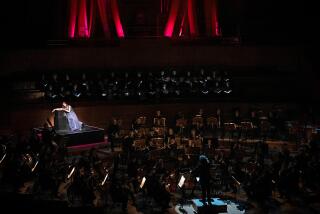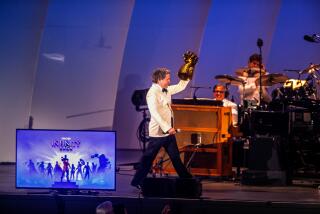MUSIC REVIEW : 1,000 Perform in Hollywood Bowl’s Massive ‘Daiku’
- Share via
In the spirit of bigger is better and more is more, more than 1,000 performers from Japan and the United States got together for Beethoven’s Ninth Symphony--or, “Daiku,” meaning “nine,” as it is familiarly known in Japan--at Hollywood Bowl Saturday night.
Beethoven survived.
In imitation of even more massive Ninths sung annually in Japan, this event was the first of what the organizers hope will be yearly “Daiku” concerts here.
Hiroshi Ishimaru, a onetime student of Herbert von Karajan and apparently one of Japan’s top conductors, duplicated his Sumida City, Japan, role as leader of the throng. The Los Angeles Chamber Orchestra and the Japan America Symphony combined to form the orchestra.
Seven Southland choirs and three from Japan--947 singers in all--coalesced into the vocal battalion. In attendance were 14,828 listeners.
Since a bleacher-type arrangement to accommodate the choirs had been set up within the Bowl shell, the orchestras themselves sat atop a stage well in front of the structure, with a resulting loss of power and luster to their sound.
On the first half, Heiichiro Ohyama--conductor of the Japan America Symphony--led the orchestras in a generous and detailed account of Dvorak’s “New World” Symphony, taking time to explore its byways, in a well-groomed performance.
After all of the singers settled themselves, the 72-year-old Ishimaru delivered a stately and gracious reading of the Ninth, finding dramatic breadth, despite amplification imbalances, where he needed it.
In the finale, baritone Toshimitsu Kimura and tenor Mark Thomsen resolutely belted out their solos and swamped what sounded like solid contributions from soprano Yukie Okura and mezzo-soprano Nancy Maultsby.
Naturally, the choirs--including the Gay Men’s Chorus of Los Angeles and the Korean Master Chorale (also local)--made a big noise but, not so naturally, not a laborious one. They sang with neatness and spirit, becoming woolly in only one of Beethoven’s more complex sections.
Ishimaru even stood back and put his hands down once, letting them go confidently on their own. Probably nothing was going to stop them anyway.
More to Read
The biggest entertainment stories
Get our big stories about Hollywood, film, television, music, arts, culture and more right in your inbox as soon as they publish.
You may occasionally receive promotional content from the Los Angeles Times.










